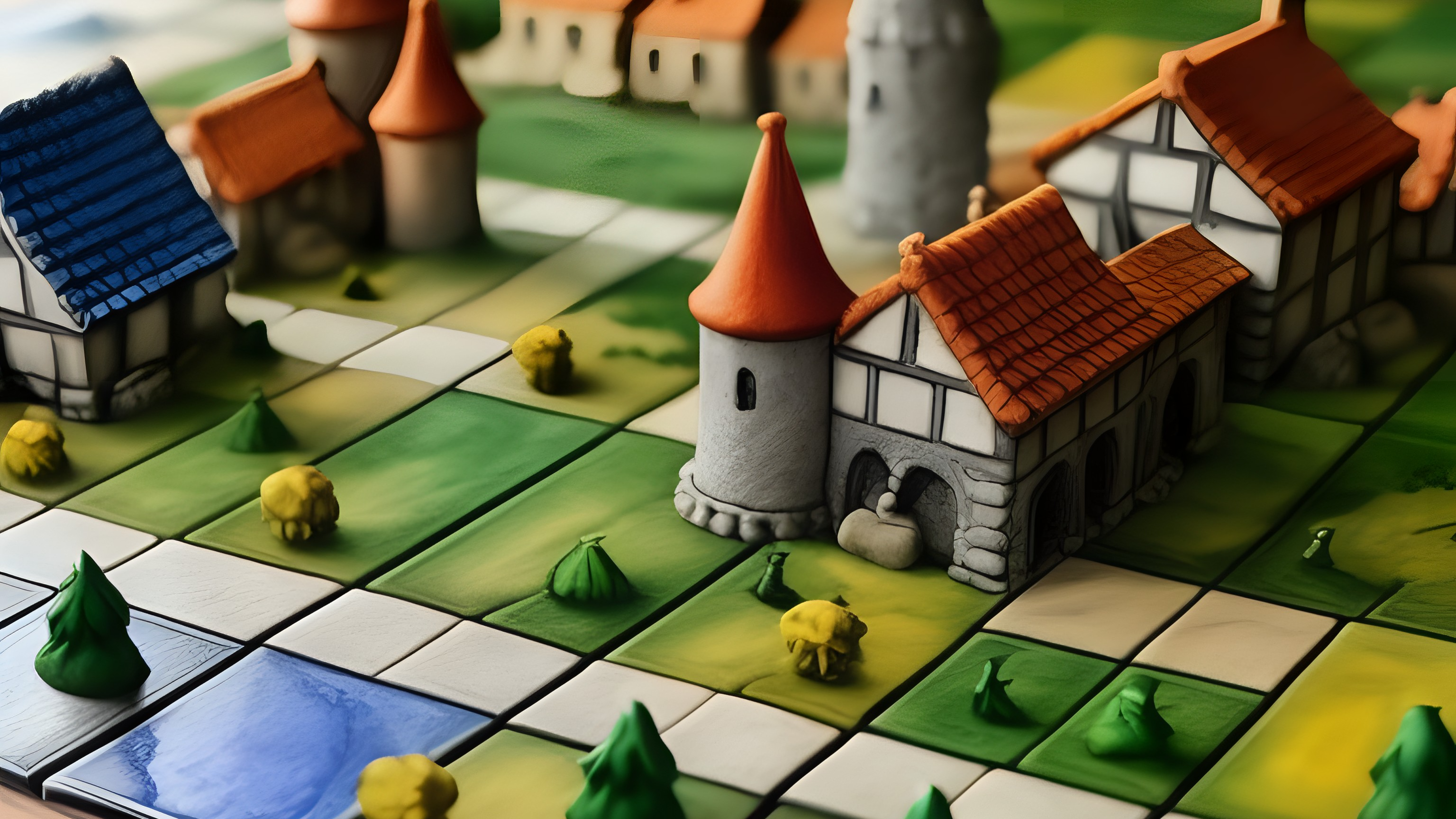
Carcassonne transforms simple tile laying into an intricate tapestry of medieval landscapes, where strategy intertwines with a charming narrative of territorial conquest.
Each game unfolds as a unique mosaic of walled cities, cloistered monks, fertile fields, and distant roads - a puzzle crafted by the players' hands that entices the imagination and intellect.
At its core, Carcassonne is an exercise in strategic placement, where players take turns drawing and placing tiles to build their medieval realm. These tiles depict fragments of cities, roads, monasteries, and fields, which players connect to existing features on the board, expanding their territories turn by turn.
While placing these tiles, participants deftly deploy their "meeples" – small, game-piece avatars – onto the evolving landscape to claim ownership over the features they're constructing. Whether it is a knight overseeing a city, a thief prowling a road, or a farmer tending the fields, the placement of these meeples is critical. They represent control and, upon completion of a geographical feature, the opportunity for scoring points that edge players closer to victory within Carcassonne's ever-changing medieval tapestry.
Initiating a game of Carcassonne begins with placing the starting tile, the only pre-determined component in an otherwise mutable landscape. Ensuing tiles are drawn randomly, each player crafting their medieval terrain from scratch.
The selection and placement of tiles constitute the heart of your strategic endeavor in Carcassonne, which is akin to laying the foundation for a burgeoning medieval domain. Drawing from a shuffled face-down pool, each player expands the territory with care and prudence.
Carcassonne's tile-based system fosters a unique gameboard with each new session.
Upon drawing a tile, players must consider optimal positions relative to existing tiles on the board, thus weaving their narrative within the medieval mosaic. Strategy intertwines with serendipity – while planning your domain, you must adapt and overcome the notion of the tile draw. The resulting tableau is one of personal creation and shared history.
Each piece in Carcassonne embodies a distinct pivotal role for strategic area control.
Precise placement of these pieces, known as "meeples," determines territorial claims and scoring potential.
Each tile alters the dynamic landscape, prompting players to adapt their roles accordingly.
Understanding the symbiotic relationship between tiles and meeples is crucial for mastering Carcassonne's strategic depth.
To triumph, Carcassonne demands astute foresight and tactical flexibility. Expert players must anticipate opponents' moves and balance aggressive expansion and defensive consolidation. The timing of meeple allocation is pivotal, as it can either secure critical points or substantially hamper future placements.
Strategic placement optimizes the utility of every tile, transforming a casual game into a cerebral contest. Mastery emerges from adapting to the vagaries of the draw and skillfully manipulating the shared landscape to outflank adversaries and accrue dominance.
Maximizing points in Carcassonne hinges on the astute placement of tiles and meeples. The strategy lies in forethought, patience, and timing.
Completing developed structures awards immediate points. Monasteries require strategic foresight.
The largest cities and longest roads often become battlegrounds for control and points. Savvy players strategize to claim these with minimal expenditure yet yield maximal rewards.
Every meeple placed is a commitment, a careful balance between current gains and potential future opportunities. Successful players keenly discern the optimal point of intersection between aggressive expansion and calculated risk—despite the random nature of tile drawing. Remember, an unplayed meeple is a lost opportunity, akin to "saving" a piece in chess without mobilizing it for optimal advantage.
Master the art of tactical obstruction.
The landscape is ever-evolving in Carcassonne, with players vying for supremacy through tile placement. True prowess, however, is exhibited in the development of one's own territories and in the strategic blocking of opponents. This maneuver requires an acute understanding of the game's mechanics and the current state of play. Additionally, successful blocking often predicates anticipation of an adversary's strategy.
A well-placed tile can hinder an opponent's progress.
Utilizing tiles to impede an adversary's expansion is a nuanced art. It's about more than placing a piece to compete with an opponent's structure directly but also about positioning tiles so that it becomes difficult for them to continue or complete their endeavors. This might entail placing a tile that interrupts the continuity of their road or city, effectively halting its expansion and limiting its scoring potential.
Blocking is a defensive and offensive tool.
While seemingly defensive, such strategies can also pave the way for offensive gains. By halting an opponent's progression, you not only prevent them from scoring but also may create opportunities to overtake incomplete features or force them into less advantageous placements. Contested features that are skillfully blocked can turn into points in your favor if you maneuver adroitly.
Effective blocking requires vigilance and adaptability.
The proficiency of blocking opponents effectively in Carcassonne involves adaptability to evolving circumstances and a vigilant approach to opponents' potential moves. Such strategic defensive play can often pave the path to victory in the game, turning the act of blocking into a subtle yet decisive tool in the arsenal of any adept Carcassonne player.
As your Carcassonne empire grows, so does the thrill of exploration and conquest within this tile-laying odyssey. With each game, new strategies unfold, novel terrains emerge, and players are drawn into the dynamic interplay of creating and commandeering vast landscapes. The variability inherent in each session boosts replayability, ensuring a unique experience every time tiles are drawn, and territories expand.
Expansions enrich the core experience by introducing fresh mechanics and elements that invigorate gameplay. These extensions cater to enthusiasts seeking to diversify their tactical repertoire, offering ways to strengthen influence over the ever-evolving medieval map. The addition of expansions bridges the base game's familiar territory and the untapped potential of new strategic horizons.
Expansions augment the Carcassonne experience, each offering unique strategic nuances.
While each expansion necessitates a recalibration of tactics, they preserve the essence of Carcassonne.
The seamless integration of these expansions into the core game makes them highly commendable.
Integrating multiple expansions can dramatically rejuvenate Carcassonne's dynamics, offering many novel strategies.
With carefully selected expansions, Carcassonne transforms into a virtually new game each session.
Use expansion combinations judiciously to maintain the game's core aesthetic and strategic foundation.
Knowledgeable mixing of expansions in Carcassonne results in a reinvigorated board game landscape—endlessly explorative and strategically rich.
Carcassonne's emphasis on player interaction fosters a convivial atmosphere where bonds are strengthened through shared decision-making and tactical cooperation. With each tile placement, participants engage in a subtle dance of alliance and competition, creating a social fabric interwoven with the medieval landscape's development.
The tabletop becomes a meeting ground for minds, where conversation and strategy intertwine. This creates a memorable tableau not just of a game in play but of camaraderie and connectedness that transcends the boundaries of the board.
Carcassonne's intuitive gameplay makes it an exceptional medium for family interaction. Laying down tiles fosters communication and collaboration, underpinned by a spirit of fun.
Strategically, Carcassonne operates on multiple levels, allowing players of varying ages to enjoy it together. Its capacity to offer a leveled playing field is uncommon in a complex world.
The game encourages creative problem-solving and negotiation, skills as valuable at the board as they are in life. Thus, the dynamics of relationship-building are seamlessly interwoven with each game session.
Carcassonne's balance of luck and strategy means that all family members can celebrate victories and learn from defeats without any player feeling outmatched. It invites everyone to the table, blending synergistic and competitive interactions equally.
Providing entertainment and life lessons, Carcassonne stands as an instrument for unity and educational growth within the family unit, reinforcing ties through the elegance of play.
The online Carcassonne community thrives with discourse on strategy and camaraderie beyond the physical game night. Experts and novices alike can find a welcoming platform for growth.
Virtual matches connect players globally, integrating diverse tactical approaches and styles. Insight into the global meta-game is a click away.
Collaboration with fellow enthusiasts via forums and chat rooms can deepen one's understanding of nuanced strategies. It's a realm where the subtleties of tile placement and the intricacies of farmer scoring are earnestly debated, enhancing the collective wisdom of its members.
Online tournaments offer layers of competitive play, infusing the classic board game with dynamic energy. Participating in these events not only sharpens one's strategic understanding but also grants a sense of belonging within a community that values sportsmanship and deep engagement with the mechanics of Carcassonne. It is akin to being a member of a discerning and intellectually vibrant club that cherishes innovation within the confines of the game's traditional rules.

